The rear of these premises opens out onto Justice Mill Lane, which takes its name from two medieval mills situated in the vicinity of the early courts of justice.
Prints and text about The Justice Mill.

The text reads: This Wetherspoon bar takes its name from the two medieval mills once situated to the rear of this building on the south side of today’s Justice Mill Lane. The Upper and Lower Mill were originally known as Justiciar’s Mills. First mentioned in a charter of 1343, the two corn mills were driven by the waters of the Howe Burn. This name was later anglicised into ‘Holburn’, as in nearby Holburn Street. Also to the rear of this building is the old Hardgate Well, which was blocked up around 1940. Water House, opposite these premises, once contained the reservoir for part of Aberdeen’s water supply pumped from well on the north bank of the Dee.
Prints and text about Lord Aberdeen.
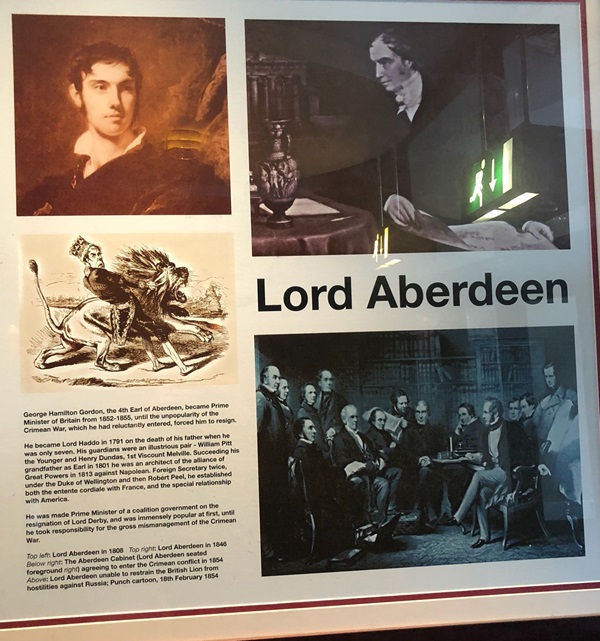
The text reads: George Hamilton Gordon, the 4th Earl of Aberdeen, became prime minister of Britain from 1852-55, until the unpopularity of the Crimean War, which he had reluctantly entered, forced him to resign.
He became Lord Haddo in 1791 on the death of his father when he was only seven. His guardians were an illustrious pair – William Pitt the Younger and Henry Dundas, 1st Viscount Melville. Succeeding his grandfather as Earl in 1801 he was an architect of the alliance of Great Powers in 1813 against Napoleon. Foreign secretary twice, under the Duke of Wellington and then Robert Peel, he established both the entente cordiale with France, and the special relationship with America.
He was made prime minister of a coalition government on the resignation of Lord Derby, and was immensely popular at first, until he took responsibility for the gross mismanagement of the Crimean War.
Top left: Lord Aberdeen in 1808
Top right: Lord Aberdeen in 1846 Below right: The Aberdeen Cabinet (Lord Aberdeen seated foreground right) agreeing to enter the Crimean conflict in 1854
Above: Lord Aberdeen unable to restrain the British Lion from hostilities against Russia; Punch cartoon, 18 February 1854.
Prints and text about We Twa – Lord and Lady Aberdeen.
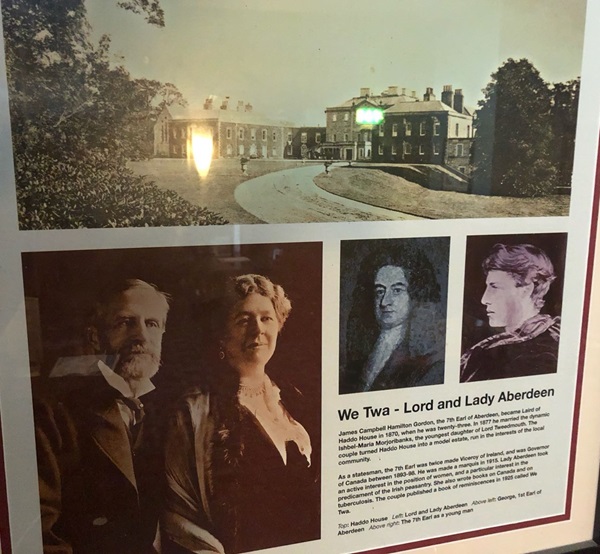
The text reads: James Campbell Hamilton Gordon, the 7th Earl of Aberdeen, became Laird of Haddo House in 1870, when he was twenty-three. In 1877 he married the dynamic Isabel-Maria Morjoribanks, the youngest daughter of Lord Tweedmouth. The couple turned Haddo House into a model estate, run in the interests of the local community.
As a statesman, the 7th Earl was twice made Viceroy of Ireland, and was over or of Canada between 1893-98. He was made a marquis in 1915. Lady Aberdeen took an active interest in the position of woman, and a particular interest in the predicament of the Irish peasantry. She also wrote books on Canada and on tuberculosis. The couple published a book of reminiscences in 1925 called We Twa.
Top: Haddo House Left: Lord and Lady Aberdeen
Above Left: George, 1st Earl of Aberdeen
Above right: The 7th Earl as a young man.
Photographs and text about Union Street.
The text reads: By the end of the 18th century Aberdeen needed to expand. The rate-paying citizens were canvassed, and a proposal agreed, authorised by Act of Parliament in 1800, to make two new streets – Union Street and King Street.
Union Street was named to commemorate the Union of Great Britain with Ireland in January 1801. The north face of St Katherine’s Hill had to be cut through, and its summit lowered – a major engineering challenge at the time. The street level then had to be built up on massive brick arches, from Market Street to Union Bridge, which remain largely hidden from view.
Union Street originally stretched from Castlegate in the east, to Summer Street; beyond which ran a narrow road giving rear access to a line of houses fronting Justice Mill Lane. This became a continuation of Union Street, and looks its name in 1890. It remained, however, narrower than the rest of the street.
Top: Holborn Junction, c1888
Above: Union Street looking east, c1860
Left: Union Bridge from Crown Terrace, 1853.
Prints and text about Alexander Hall & Co.
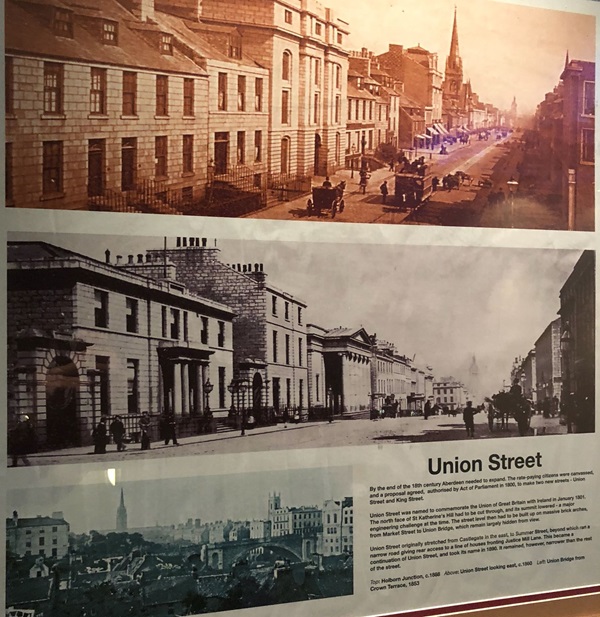
The text reads: The Scottish Maid was a small streamlined schooner built in Aberdeen, in 1839. She was the first of many long distance sailing ships built by Alexander Hall & Sons for the China tea trade.
Prints of ship-building in Aberdeen.

Prints and text about Union Street.

The text reads: Laid out in the 1830s, this mile-long thoroughfare is Aberdeen’s main street. Until 1890 the west end was known as Union Place. The houses were fronted by the railings and had steps up to the front door, which were replaced as Union Street became more commercial. Union Place included what are now numbers 423-425 Union Street. Number 423 is a listed building dating from 1821. From the 1890s it was occupied first by a costumer, followed by a dressmaker, and then a tailor from the 1920s into the 1960s.
Until then, number 425 Union Street had been occupied by a fruit merchant for around fifty years. Today, these two buildings have been combined to form the Lloyds No.1 Bar called The Justice Mill.
Prints and text about Archibald Simpson.
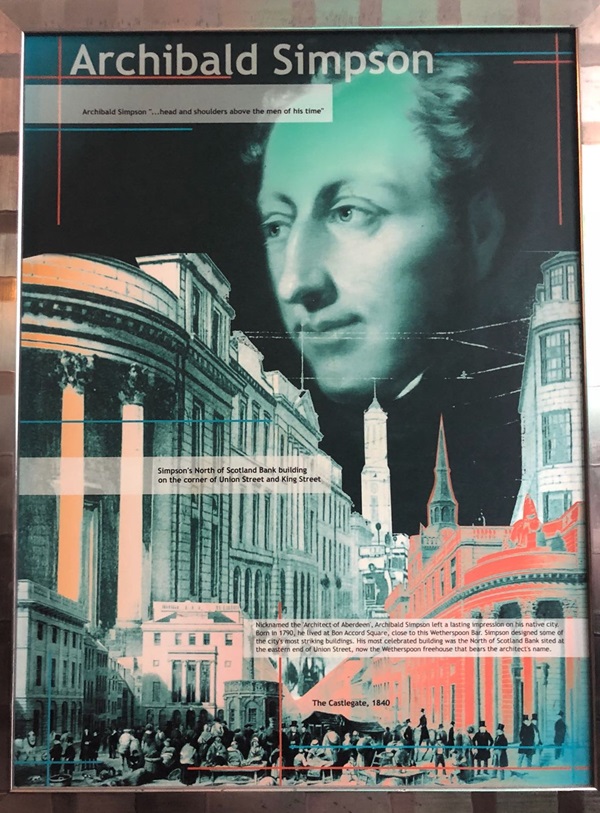
The text reads: Nicknamed the ‘Architect of Aberdeen’, Archibald Simpson left a lasting impression on his native city. Born in 1790, he lived at Bon Accord Square, close to this Wetherspoon Bar. Simpson designed some of the city’s most striking buildings. His most celebrated building was the North of Scotland Bank sited at the eastern end of Union Street, now the Wetherspoon free house that bears the architect’s name.
External photograph of the building – main entrance.
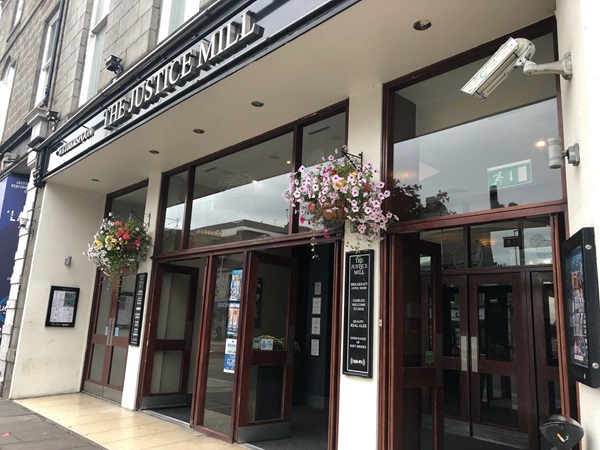
If you have information on the history of this pub, then we’d like you to share it with us. Please e-mail all information to: pubhistories@jdwetherspoon.co.uk